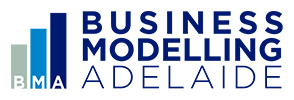Financial Modelling
Business Modelling Adelaide – The virtual CFO
Good financial modelling involves understanding a business’ revenue stream (via analysis), isolating the main sales drivers, identifying the relationship with key expenses, and being able to bring all of this together into an easy to use and view Excel model.
Financial forecast model
At BMA we focus on understanding a business’ key drivers (sales and expenses) and identifying the levers to improve these metrics. The purpose is to narrow a business’ focus to the things that really matter and drive improvement.
These key drivers are incorporated into a financial forecast model built on a set of key assumptions. This allows us to test different scenarios, provides a view of the future, identifies any concerns and gives targets to strive for.
Once a financial forecast is established it should become a live document for the business ie. a rolling forecast – reviewed, refined and updated on a regular basis and rolled forward to stay at least 6 months out. This necessarily includes reviewing the underlying assumptions and actual performance.
The financial model can have sensitivity analysis built in, an ability to compare different scenarios against a base case and include calculation of KPI’s and banking covenants if required.
We typically build 3 way financial forecasts comprising profit & loss, cashflow and balance sheet reports along with KPI and scenarios sheets. Generally, a forecast is prepared on a monthly basis and for a 2-3 year period.
We approach a financial model build as follows:
- An initial meeting to discuss a client’s expectations and requirements, for us to ask some initial questions and have a general business background discussion to give us an understanding of the business.
- We then sketch out a general design, maybe with some mock-up input and output schedules and then present these back to the client. These would be included in a written proposal with cost estimates.
- Once the general design and proposal has been agreed, the model build would begin. There will be information requests and potentially meetings to review progress and initial outputs along the way.
- Complete a final draft of the model and hold a formal review with the client – functionality, look and feel and draft results.
- Make required amendments to formats and functionality and finalise results.
- Complete the model and provide to client for their use.
We aim to build a model and then hand across to the client for them to use within their business.
We have recently prepared forecasts for businesses in the following industries:
- Retail
- Manufacturing
- On-line retail
- Professional services
- Household consumer
- Racing
Cash Flow Forecasts
A short-term cash flow forecast is probably the most important report a business should have. “Cash is King” is so true. Understanding your cash position, both now and in the future, is critical. Having a good handle on this reduces surprises and allows a business owner to sleep easier.
Whilst a cash flow forecast is included in the 3-way financial forecasts described above a short-term cash flow forecast should also be maintained. This will not be so driven by assumptions but will incorporate actual debtor, creditor positions and current sales performance.
The cash flow forecast will give you a map for the next few months. It allows you to identify issues and opportunities and provides time to plan strategies and solutions to manage through these periods.
Typically, a short-term cash flow forecast should look out a minimum of 13 weeks on either a weekly or daily basis. Daily forecasts should be used where there are a number of payments in each week or where cash is tight. If your payment cycles are more controlled eg. 2 creditor payment runs per month then weekly should be enough.
Cash flow forecasts provide Business Managers with vision and better control of their business as they know what is coming and will have less surprises to deal with.

Contact us
Contact Info
Phone number: 0403 083 884
Email: john@bmadelaide.com.au
